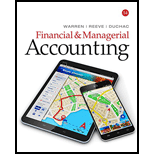
1.
Break-even Point: It refers to a point in the level of operations at which a company experiences its revenues generated is equal to its costs incurred. Thus, when a company reaches at its break-even point, it reports neither an income nor a loss from operations. The formula to calculate the break-even point in sales units is as follows:
To compute: the anticipated break-even sales (units).
2.
the amount of sales (units) if the company desires a target profit of $240,000.
3.
To construct: a cost-volume-profit chart assuming the sales of 20,000 units within the relevant range.
4.
the probable income (loss) from operations if sales total 16,000 units.
Want to see the full answer?
Check out a sample textbook solution
Chapter 19 Solutions
Financial & Managerial Accounting
- Please need answer the general accounting question not use aiarrow_forwardGroot Co. (GC) sells $1,200,000 of 6-year, 10% bonds at par plus accrued interest. The bonds are dated January 1, 2026 but due to market conditions are not issued until May 1, 2026. Interest is payable on June 30 and December 31 each year. The market rate of interest at time of issue is the same as the stated rate. Required The issuance of the bonds on May 1, 2026. Assume that GC has adopted a policy of crediting accrued interest payable for the accrued interest on the date of sale. Payment of interest on June 30, 2026. Payment of interest on December 31, 2026.arrow_forward1. Define working capital and explain its importance in financial health and liquidity management. 2. Assess how the matching concept and accrual basis affect the reporting of current assets and liabilities. 3. Using a hypothetical balance sheet (you may create one), identify at least 5 current assets and 5 current liabilities and analyze how changes in these elements affect liquidity ratios. 4. Recommend at least two strategies VinGrenDom Ltd. can implement to optimize working capital.arrow_forward
- Theron Interiors manufactures handcrafted cabinetry and uses a process costing system. During the month of October, the company started Production on 720 units and completed 590 units. The remaining 120 units were 60% complete in terms of materials and 40% complete in terms of labor and overhead. The total cost incurred during the month was $45,000 for materials and $31,200 for labor and overhead. Using the weighted-average method, what is the equivalent unit cost for materials and conversion costs (labor and overhead)?arrow_forwardGeneral Accountingarrow_forwardKamala Khan has to decide between the following two options: Take out a student loan of $70,000 and study accounting full time for the next three years. The interest on the loan is 4% per year payable annually. The principle is to be paid in full after ten years. Study part time and work part time to earn $15,000 per year for the following six years. Once Kamala graduates, she estimates that she will earn $30,000 for the first three years and $40,000 the next four years. Kamala's banker says the market interest for a ten-year horizon is 6%. Required Calculate NPV of the ten-year cash flows of the two options. For simplification assume that all cash flows happen at year-end. Based on the NPV which of the two options is better for Kamala?arrow_forward
 Managerial AccountingAccountingISBN:9781337912020Author:Carl Warren, Ph.d. Cma William B. TaylerPublisher:South-Western College Pub
Managerial AccountingAccountingISBN:9781337912020Author:Carl Warren, Ph.d. Cma William B. TaylerPublisher:South-Western College Pub Cornerstones of Cost Management (Cornerstones Ser...AccountingISBN:9781305970663Author:Don R. Hansen, Maryanne M. MowenPublisher:Cengage Learning
Cornerstones of Cost Management (Cornerstones Ser...AccountingISBN:9781305970663Author:Don R. Hansen, Maryanne M. MowenPublisher:Cengage Learning Managerial Accounting: The Cornerstone of Busines...AccountingISBN:9781337115773Author:Maryanne M. Mowen, Don R. Hansen, Dan L. HeitgerPublisher:Cengage Learning
Managerial Accounting: The Cornerstone of Busines...AccountingISBN:9781337115773Author:Maryanne M. Mowen, Don R. Hansen, Dan L. HeitgerPublisher:Cengage Learning Financial And Managerial AccountingAccountingISBN:9781337902663Author:WARREN, Carl S.Publisher:Cengage Learning,
Financial And Managerial AccountingAccountingISBN:9781337902663Author:WARREN, Carl S.Publisher:Cengage Learning,



